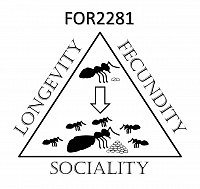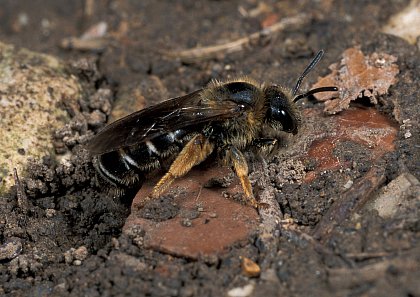Social evolution
Eusocial insects (ants, bees, wasps and termites) are an evolutionary and ecological success story. They have long fascinated biologists though their complex and highly integrated societies and at the same time challenged evolutionary theory because of the altruistic behaviour exhibited by nestmates. Insect social evolution comprises two major questions: (i) the origins of social behaviour from solitary antecedents and (ii) the functioning of social systems, in particular the balance between cooperation and conflict that is inherent to social insects. We address both questions using a range of bee species, particularly members of the family Halictidae (sweat bees), probably the most socially labile of all animal taxa, and members of the family Apidae, such as orchid bees, bumble bees and honey bees.
Facultatively eusocial sweat bees such as Halictus rubicundus make excellent subjects for analysis of the origins of social behaviour. We employ a mix of observational and experimental approaches in the field to investigate the expression of social behaviour of this species as well as next generation sequencing data to reveal the genetic underpinning of altruism.
As part of the DFG’s Research Unit So-Long , we integrate life-history theory with social evolution to explore the apparent reversal of the fecundity/longevity trade-off which accompanies insect sociality. Our study species include the honey bee (Apis mellifera) as well as the Neotropical facultative eusocial orchid bee Euglossa viridissima and a range of other bee species that vary in social organisation.


A female of the facultatively eusocial sweat bee Halictus rubicundus
Key references
Séguret, A., Bernadou, A. & Paxton, R.J. 2016. Facultative social insects can provide insights into the reversal of the longevity/fecundity trade-off across the eusocial insects. Current Opinion in Insect Science 16: 95-103. DOI: 10.1016/j.cois.2016.06.001
Kocher, S.D. & Paxton, R.J. 2014. Comparative methods offer powerful insights into social evolution in bees. Apidologie 45: 289–305. DOI: 10.1007/s13592-014-0268-3
Field, J., Paxton, R.J., Soro, A. & Bridge, C. 2010. Cryptic plasticity underlies a major evolutionary transition. Current Biology 20: 2028-2031. DOI: 10.1016/j.cub.2010.10.020
Soro, A., Field, J., Bridge, C., Cardinal, S.C. & Paxton, R.J. 2010. Genetic differentiation across the social transition in a facultatively social sweat bee, Halictus rubicundus. Molecular Ecology 19: 3351–3363. DOI: 10.1111/j.1365-294X.2010.04753.x
Our principal external collaborators
Prof. Manfred Ayasse , University of Ulm
Prof. Bryan Danforth , Cornell University
Prof. Jeremy Field , Sussex University
Prof. Judith Korb and the DFG's Research Unit So-long
Prof. Javier Quezada , Autonomous University of Yucatan



